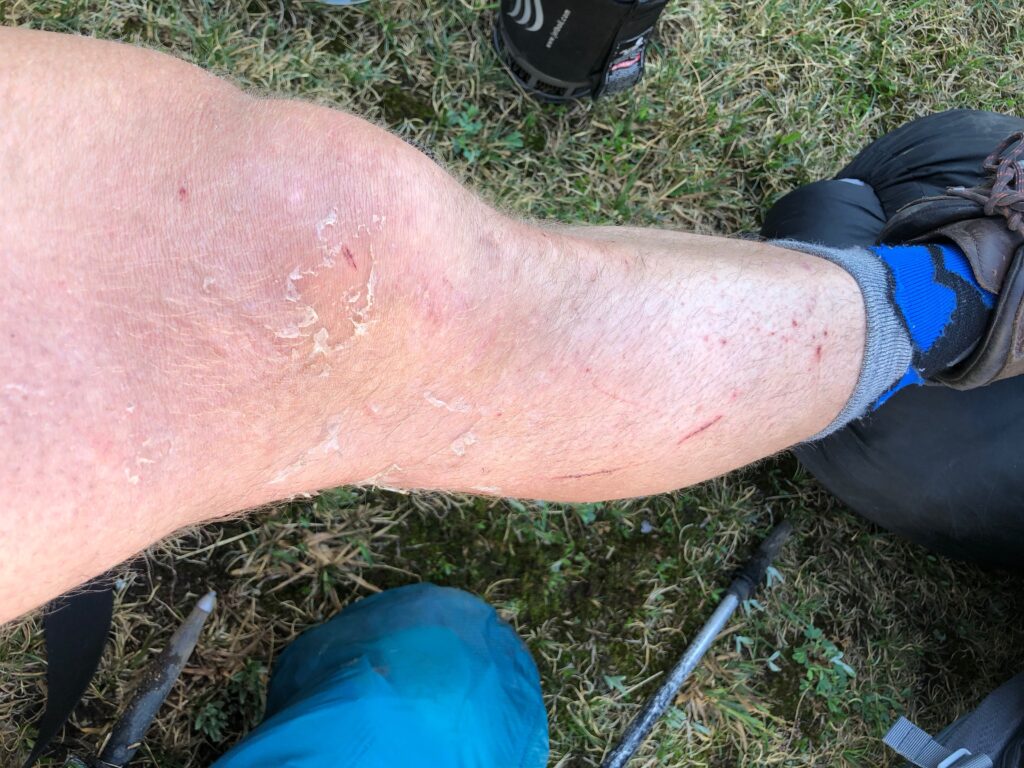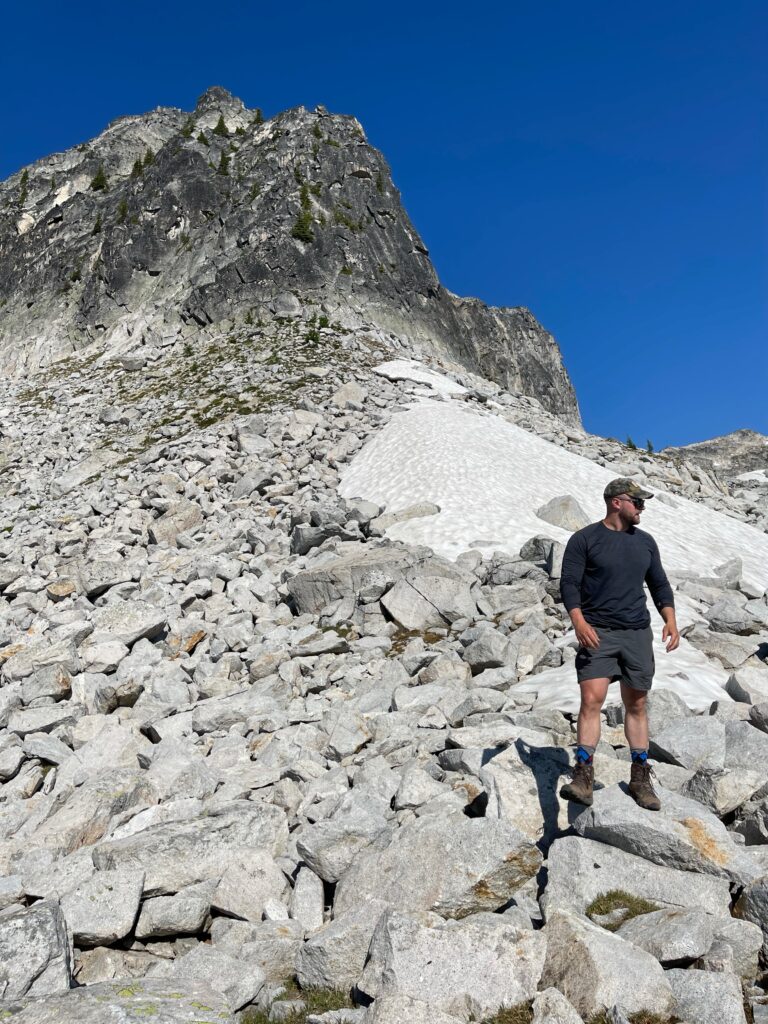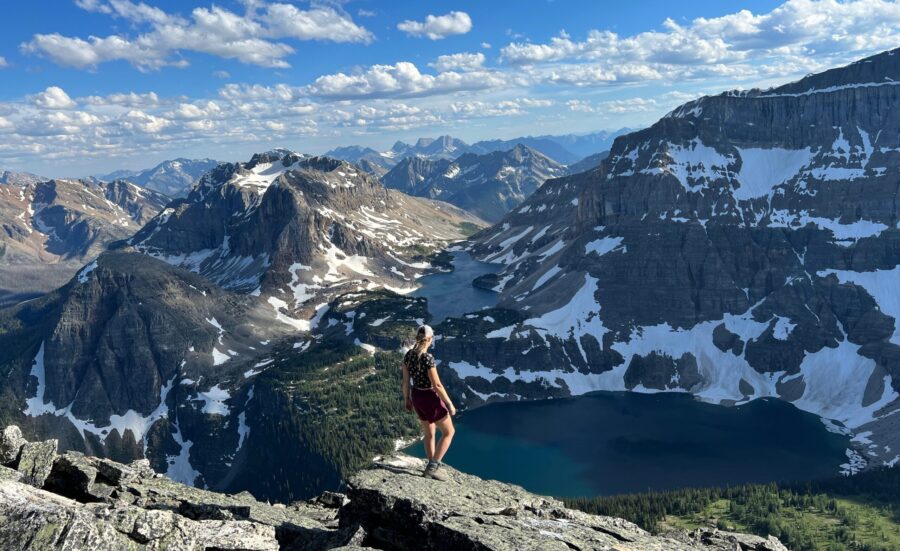Hiking in shorts might be a good idea if the weather is hot and the trail is easy to moderate difficulty. Hiking in shorts might be a bad idea if the weather is mild or if the trail is difficult. In fact, hiking in shorts could even be dangerous in a few circumstances.
I’ve hiked in shorts quite a few times, and I have regretted it about half of the time.
There are very specific circumstances in which hiking in shorts will be a pleasant, enjoyable experience. The more you know the limitations of hiking in shorts, the safer and more comfortable your hike will be.

3 Reasons Hiking in Shorts Might Be a Good Idea
If you’re feeling pretty sold on the idea of wearing shorts out on a hike, there are definitely a few benefits to doing so.
- Keep you cool – Wearing shorts on a hike will help to keep you cool, especially if you’re hiking on a very hot day or on a strenuous hike. Any amount of skin exposure allows sweat to evaporate through the sun and the wind, which in turn causes heat loss. When this is intentional, it is an excellent feature.
- Show off your legs – It might not be the main priority for everyone, but hey – if you’ve got great legs, why not show them off? Shorts can be very stylish and you might feel more confident wearing shorts than pants. If that’s the case, shorts are great for hiking.
- Easier for crossing streams – If your hike has lots of wet spots, muddy spots, or flowing water, you won’t have to roll up your pants every time it gets a bit precarious. Shorts are ready for action! If this is the case on your hike, shorts might be the better option.
4 Reasons Hiking in Shorts Might Be a Bad Idea
Although hiking in shorts sounds really tempting on a hot summer’s day, it might be the downfall of your experience, depending on a few conditions.
The following four reasons are usually what cause me to regret my decision to hike in shorts. Occasionally the stars align where it’s so hot out that I can’t imagine having anything but shorts on, but those circumstances feel few and far between in the Rocky Mountains.
- Might be too cold – Although when you start your hike the weather might be hot, weather can change quickly in the backcountry. Even a strong wind can give you the chills. As well, if you find you’re losing heat quickly and are too cold, it will be hard to warm up in shorts.
- Tend to ride up – Shorts tend to ride up, roll up, or get “gobbled up” by thighs during activity. Longer shorts can sometimes avoid this phenomenon, but shorts rarely stay where you want them during activity. This can lead to chafing.
- No protection for lower legs – If you’re clumsy, hiking through thick brush, or “bushwhacking” through no discernible trail, you might find your lower legs get scratched up. Shorts offer no protection from the environment. Additionally, watch out for allergens, like poison ivy, which will brush your bare skin.
- May sunburn – Shorts offer no protection from the sun’s harmful rays. You can end up with painful sunburns or some funky tan lines between your shorts and hiking boots.

4 Things To Consider When Choosing Shorts For Hiking
Whether you’re considering hiking in shorts you have in your closet, or you plan on buying a pair of shorts that you could use hiking, here are a few things to consider about any particular pair of shorts before taking them on the trail:
1. Material
Look at the tag on the shorts and read what material they are made of.
Shorts made with cotton will absorb sweat easily, and they likely won’t dry while you’re still hiking. This means that your shorts might feel uncomfortable and wet, plus they also might feel cold in a breeze. This might not be a bad thing on a very hot day, but it’s something to consider.
Shorts made of synthetic materials (nylon, polyester, acrylic, spandex) will perform a bit better, as they will wick sweat away from your body and dry faster. They might not be as comfortable as a cotton pair of shorts or a cotton-blend, but they do tend to make better hiking shorts.
2. Length
The length of the short might make a difference while you’re hiking.
If you prefer a certain length, that’s something to take into consideration, but different lengths also can affect how you walk. Shorter length shorts can bunch up between your legs, but they also might keep you feeling cool. Longer shorts might stay put, but they also might be too baggy.
Length isn’t necessarily an excluding factor, but is something to think about when choosing a hiking short.
3. Waterproof
If your shorts are waterproof, you might be better prepared for any conditions you may encounter on the trail. Some shorts, on the other hand, may absorb water easily. This may or may not be a problem, depending on the amount of water and how short the hike is.
4. Purpose
If you think about what the shorts are intended to be used for, it might give you a good indication of their performance as a hiking short. Shorts that are made for athletic activity or exercise will likely do well as a hiking short.

What Shorts Do You Wear Hiking?
Shorts that are specifically made for hiking are what you should hike in, if the conditions are appropriate for shorts. They are referred to as “hiking shorts”.
However, you can hike in any shorts, particularly if the hike is easy or short. For information on hiking in other types of shorts, keep an eye out for my other articles.
What is Special About Hiking Shorts?
Hiking shorts are special because they aim to tackle all the problems you might encounter while hiking. Although hiking shorts can come in a variety of styles, they tend to be a bit looser, have several pockets, and are considerably durable. Many pairs also have a water-resistant coating.
Hiking shorts tend to out-perform other kinds of shorts while hiking, though they are only appropriate for warm weather conditions. If the weather is cooler, consider hiking in pants instead.
Pros of Wearing Hiking Shorts
- Durable – Hiking shorts are meant to stand up to all the stresses that a hiking trail can throw at you. They are made from a durable material
- Pockets – Hiking shorts often have a multitude of pockets, which is convenient when you’re hiking and don’t want to stop to grab your phone or some snacks.
- Water-Resistant – Hiking shorts often have a water-resistant coating which is excellent when you encounter inclement weather or spill water on yourself while you’re trying to drink and catch your breath at the same time.
Cons of Wearing Hiking Shorts
- Expensive – Because hiking shorts are branded as such, they tend to be a bit more on the expensive side, especially if you go with a name brand like Patagonia or Arcteryx. However, it is worth the cost if you’re willing to spend a pretty penny.
- Difficult to Multi-Purpose – Hiking shorts can be a little tricky to wear casually or for other activities since they have a very specific look. There’s no reason you can’t use them for other things, but it might not be overly trendy to do so.

Questions?
Do you wear shorts when hiking? Why or why not? When do you find shorts work best for hiking? Drop a comment below and I’ll get back to you!
Happy trails!

